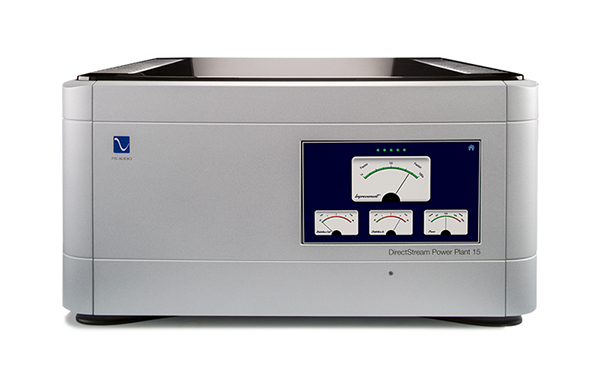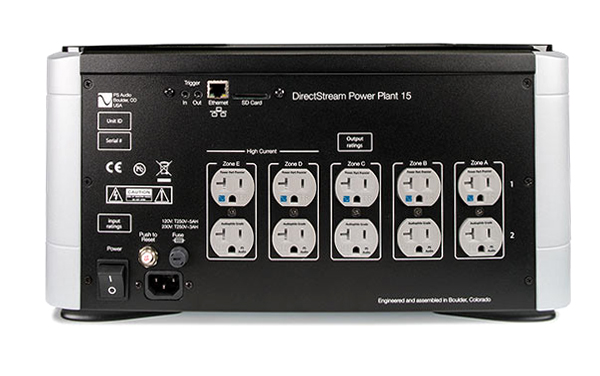The PS Audio DirectStream P15 Power Plant As clean as AC can get
By Jeff Dorgay Last year, we published a very enthusiastic review of PS Audio’s top P20 DirectStream Power Plant. It’s awesome, and every audiophile cliché you can think of applies. So we don’t need to go there again.
Last year, we published a very enthusiastic review of PS Audio’s top P20 DirectStream Power Plant. It’s awesome, and every audiophile cliché you can think of applies. So we don’t need to go there again.
If you’d like to hear all the lavish praise, click here to read our review of the P20. At just a few molecules under $10,000, the P20 is not for everyone. The $7,495 P15 will perform the same miracles on your system and is sonically identical, except for a few minor differences. Where the P15 has a lower maximum capacity (1500 watts vs. 2000) it also only has the ability to utilize a 15-amp AC cord, where the P20 lets you take advantage of a 20 amp AC line and cord, the P15 does not. And it weighs a little less, which isn’t a bad thing.
The P15 features 10 outlets, to the P20s 16, but for most audio enthusiasts, that should be more than enough. With two “high current” zones and three regular zones, it’s easy to plug your power amplifier or integrated into the high current outlet, while plugging your DAC, phonostage and turntable all into separate zones of their own.
Originally, this was going to be an incredibly short review, because as long as you keep the P15 within operating limits, the sonic effect is identical to what the P20 offers. The P15 is the perfect choice for those not needing the full 20-amp capacity of the P20; some of you won’t even need the capacity of the P15. For those of you, PS Audio makes the P12, priced at $4,995.
Let’s address the elephant in the room right away. Yes, the P15 is worth the price to me, because in the context of the system that it’s powering (worth about $40k) there is way more than a 20% improvement. That’s always tough to quantify, and always easy when I’m spending your money, so I get it if this has you outraged.
The last six feet
However, what the P15 does, you really can’t get any other way. The top passive conditioners get you closer, but they don’t offer the last bit of silky smoothness without compromising resolution and dynamics that the Power Plants do because they actually regenerate and rebuild a fresh AC feed to your components – hence the name.
The argument that every crabby pants non-believer on the internet has is “but if the power has traveled all this way to my house, what does the last few feet make?” I could write another article on why I don’t agree with that philosophy, but to blow that out of the water completely, let’s start with fresh power right at the bottom of your audio rack. Now what do you non believers have to say?
Because the Power Plant is providing you with fresh AC, that six feet of power cord now makes an even bigger difference. The P15 and P20 make it much easier to discern the improvement that a premium power cable provides. You need look no further than the touch panel scope on the front panel of the P15 to see it in action. In my office/studio which features recent cabling and more attention to the Earth ground, the AC power only had an input distortion of 2%, coming from a 20 amp dedicated line and new breaker panel. In my house, with older wiring and a breaker box from the early 70s, that distortion rises to 3.5%. Interesting. Both Power Plants reduced output distortion to around .1%, a major increase in clarity.
Plugging an electric drill into the same outlet and pulling the trigger makes that figure jump up to nearly 10%, so while you might be thinking you’ve got clean power, everyone on your power pole’s transformer is contributing to the pollution in your power line. This is a lot of the haze and cloudiness that you might be hearing through your system without any attention to power treatment. This is also why your system sounds better at certain times of the day.
This distortion in the AC line is a major contributor to your system not giving you all the performance you paid for. Less distortion in the incoming AC power means that the power supply in your components work that much less, with less residual noise is getting through to your speakers. The P15 offers an ease that isn’t there without it being in the line, with no loss in transient impact or detail, a peril that more often than not plagues passive line conditioners.
A fresh start
Eliminating the other people on your power line gives you a clean baseline to start from. Perhaps the biggest benefit to have a Power Plant is that your system will always sound its best, day or night. Because it is generating power from scratch, you no longer need to worry about temporary power sags from other things like a refrigerator, water heater, or other appliance turning on at random when you’re in the middle of a listening session.
Adding the P15 to a system consisting of a VAC 170i integrated amplifier, Simaudio MOON 390 DAC/streamer and a Luxman PD 171A turntable doesn’t come close to taxing its maximum power capabilities. Again, the front panel display will tell you how much capacity you are using. In this case, about 39%. Swapping the VAC for the Nagra Classic preamplifier/Pass Labs XA30.8 amplifier (pure class A) upped the utilization to about 55% – still plenty of room.
Both amplifiers were driving the Focal Kanta no.3s, which are fairly efficient, but on hard musical peaks, both amplifiers were able to be driven to clipping and susceptible to voltage sag on the AC line at high volume without the P15. Installing the P15 eliminates this effect, yet you will get a similar “flattening” effect if you run the P15 very close to its limitations. The good news is that limit is much further down the road with the P15 on the job.
It’s not just about loud
As anyone who’s been following the loudness/compression wars for any period of time knows, getting louder isn’t the trick to volume. It’s all about dynamic range – make things quieter and the delta between loud and soft is volume. It’s like reducing the weight of a race car instead of just adding more horsepower.
This is where the P15 (and P20) really excels. Of course, your favorite records will have more life, dynamics and detail, but so will all the records (I use this term generically for analog and digital files) that you thought were marginal to shitty. Should you demo a P15 for yourself, I suggest starting with a few of your worst tracks – ones you might even think unlistenable. You’ll be surprised. I was shocked at how many albums in the junk bin became much more enjoyable. The amount of low level detail revealed by clean power is incredible. That alone is worth the price asked of the P15. Imagine getting another thousand LPs for free that you now love. What’s that worth to you?
The effect on analog and digital sources is equally bold, yet different. Every DAC plugged into the P15 instantly displays less harshness and glare – all the stuff you hate about digital, is now either gone or greatly diminished. Every phonostage exhibited a lower noise floor, especially those with vacuum tubes under the cover, allowing more of the finest musical details to come through. I guarantee you will have at least a few “wow, I never heard that” moments with the P15.
I have the same suggestion I did with the P20 – get one if it makes sense for your budget. On one level the P15 offers more than a component level upgrade because dropping another 5 or 10 thousand bucks on a better component, or a set of world class power cords still leaves the noise in your entire system un-adressed.
If you are at a crossroads in your system where you are seriously considering a component or cable upgrade in this range, I strongly suggest that you audition a P15 first. I am confident you will hear a tremendous difference. And that goes for those of you at the top of the mountain.
The PS Audio P15
MSRP: $7,495
Peripherals
Analog Source Luxman PD 171 w/Kiseki Purple Heart
Digital Source Simaudio MOON 390, dCS Vivaldi One
Amplifier VAC Sigma 170i integrated, Pass Labs INT-60 integrated
Speakers Focal Kanta no. 3
Cable Cardas Clear Beyond, Tellurium Q Black Diamond
Rack Quadraspire EVO



